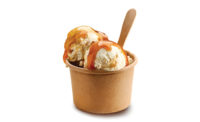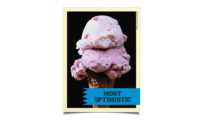Sponsored by:

The ice cream category shares many of the same themes seen in other categories of dairy foods and beverages. Manufacturers are experimenting with new flavors and inclusions, they are cleaning up the ingredient statement, and addressing consumers desires for portable, on-the-go formats. And, of course, ice cream manufacturers face fierce competition for shelf space in the frozen dairy case.
Perhaps the biggest obstacle is consumer demand. Americans don’t buy as much ice cream as they used to and manufacturers aren’t making as much anymore. Ice cream production hit a five-year low in 2014 and the numbers for 2015 aren’t looking any better. Through August, production was down 0.8% compared to the previous year, to 525 million gallons, according to the National Agricultural Statistics Service of the U.S. Department of Agriculture. Annual consumption, as measured by retail sales, increased just 0.1% according to IRI, a Chicago-based market research company. A scrap of good news for the industry was that dollar sales rose 2.5%, thanks to a 9-cent average increase in price.
Manufacturers of ice cream, gelato, frozen yogurt, novelties and other frozen desserts talk about consumers’ desire for indulgence. That often plays out in mouthfeel and flavors or inclusions. Yet consumers of dairy desserts are no less interested in the ingredient deck than are consumers of other dairy foods and beverages.
As Beth Bloom of the market research firm Mintel writes elsewhere in this issue (see page 33), “While indulgence plays a strong role, health awareness exists: 19% of frozen treat buyers say they are buying less because the products are unhealthy. And though 95% of consumers eat ice cream for dessert (with any frequency), fruit and yogurt are more likely to be turned to with high frequency, suggesting moderation.”
How are creameries addressing consumer health needs? Cleveland-based ice cream maker Pierre’soffers lactose-free ice cream in vanilla and chocolate. Its Pierre’s Slender No Sugar Added Reduced Fat Ice Cream assortment “has been a popular favorite for a long time and features six flavors,” said Matt Thornicroft, the company’s assistant marketing and communications manager.
Then there are high-protein and low-glycemic desserts, which don’t meet ice cream’s standard of identity but are sold in the frozen dairy case. Amit Pandhi, the CEO of San Diego-based Artic Zero, said his all-natural pints “fill a void in the frozen case.” That void is “guilt-free indulgences,” he added.
One serving of Artic Zero contains 3 grams of protein, derived from WPC-80, an ingredient made from whey.
Brio is another low-sugar frozen dairy dessert brand offering 6 grams of protein per serving. It offers a veritable kitchen sink of nutritional buzzwords, including: “a rich dose of calcium,” magnesium, vitamin D, 24 other vitamins and minerals, omega 3-6-9, prebiotic fiber, antioxidants and selenium. The dessert is sold in 4-ounce and 14-ounce containers.
Brio is a brand of Nutricopia, which developed NuScoop for the organic dairy Straus Family Creamery, Petaluma, Calif.
Also making health claims about their frozen desserts are gelato makers, who point out that a serving of gelato has less fat than ice cream (because gelato is not made with cream). Still, gelati are considered a treat that is offered in a wide variety of flavors.
“Gelato is an indulgence,” said Simona Faroni, the co-founder of G.S. Gelato, Fort Walton Beach, Fla. She said the company’s focus is on “simplicity, naturally natural, clean label, gluten-free and non-GMO.”
Unilever, the leader in gelato sales in the United States, added four flavors to its Breyers Gelato Indulgences line this year: chocolate caramel, mint chocolate, strawberry truffle and cappuccino. They are sold in clear 28.5-ounce containers. Unilever’s newly acquired brand Talenti introduced three limited-time offerings this fall: pumpkin pie, eggnog and peppermint bark. These are sold in clear 14-ounce plastic screw-cap jars.
Flavors abound in the category, regardless of ice cream, gelato or frozen dairy dessert. Heading the list is caramel, especially paired with sea salt. This summer Pierre’s released its Sea Salt Caramel Toffee Crunch, made with caramel ice cream with chocolate-covered toffee and a sea salt caramel swirl. The flavor is from its Premium Ice Cream line. Mayfield Dairy Farms, Athens, Tenn., rolled out a limited-time offer called Sea Salt Caramel Cheesecake.
A second Premium Ice Cream flavor introduced by Pierre’s this summer was Pretzel Sundae, made with vanilla ice cream, chocolate-covered pretzels and thick fudge. The ice cream maker added two flavors to its Signature Ultimate Ice Cream collection: Speculoos Cookie Butter (vanilla ice cream, speculoos cookies and ribbons of speculoos cookie butter swirl) and Cookie Butter Fudge Chunk (vanilla ice cream, speculoos cookies, fudge chunks and speculoos cookie butter swirl).
Mayfield’s other limited-time offerings this year were cherry chocolate chip, Yellow Brick Road (chocolate-covered peanuts in vanilla ice cream) eggnog-flavored custard and peppermint stick.
Water ice, fruit bars
Makers of nondairy frozen desserts continue to add flavors to their products. Rosati Ice, located near Philadelphia, added holiday flavors to its line of Italian ices. Flavors are pumpkin, eggnog and peppermint. They showed up in 2-quart pails in October in Acme and Weis grocery stores. All three holiday ice flavors are gluten-free, cholesterol-free and lactose-free.
CEO Rich Trotter said the company developed the holiday flavors because “we discovered many Italian ice fanatics who are sad when the summer water ice season ends.”
The frozen dessert category is not immune from consumers’ calls for sustainable farming and manufacturing processes. In March, Unilever said it would source sustainably farmed fruit to make its Fruttare frozen fruit bars. Strawberries are from California, coconut from the Philippines and bananas from Ecuador.
Unilever also is following a licensing strategy. Its Popsicle brand developed a line called Frozen, inspired by the popular Disney movie. And Popsicle Tootsie Pops are based on the candies by Chicago-based Tootsie Roll Industries.
Mars Ice Cream, Burr Ridge, Ill., also licenses candy brands of its parent Mars Inc. and sister company Wrigley. Products include Dovebar, Twix, Milky Way and Snickers ice cream bars and Starburst sorbet bars.
Conclusion
Despite lagging sales, ice cream companies keep at it. Ice cream makers can take heart in the fact that eight of 10 adults eat frozen treats, and that ice cream is more popular than pie, according to Mars Ice Cream, citing research by Mintel. The so-called Millennials (ages 18 to 34), more than any other age group, say ice cream is their favorite summer food.
“Shelf space has always been hard-fought,” said Pierre’s Thornicroft. “In the end, it’s about offering exciting, quality-made flavors people not only enjoy, but enjoy so much they return for more and share their delicious new discovery with friends and family.”
52 weeks ended Aug. 9, 2015. Total U.S. Multi-Outlet w/ C-Store (Supermarkets, Drugstores, Mass Market Retailers, Gas/C-Stores, Military Commissaries and Select Club & Dollar Retail Chains). Source: IRI, Chicago
Milk | Cheese | Cultured | Ice Cream | Butter | Non-dairy Beverages | Ingredients | Exports













